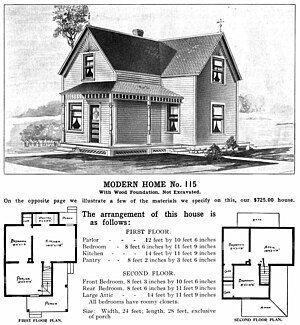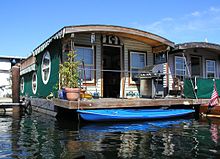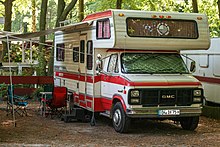Home
| Part of a series on |
| Living spaces |
|---|
 |
A home, or domicile, is a space used as a permanent or semi-permanent residence for an individual, group or family. It is a fully or semi sheltered space and can have both interior and exterior aspects to it. Homes provide sheltered spaces for instance rooms, where domestic activity can be performed such as sleeping, preparing food, eating and hygiene as well as providing spaces for work and leisure such as remote working, studying and playing. Physical forms of homes can be static such as a house or an apartment, mobile such as a houseboat, trailer or yurt or digital such as virtual space.[1] The aspect of ‘home’ can be considered across scales, from the micro scale showcasing the most intimate spaces of the individual dwelling and direct surrounding area to the macro scale of the geographic area such as town, village, city, country or planet.
A principle of constitutional law in many countries, related to the right to privacy enshrined in article 12 of the Universal Declaration of Human Rights[2] is the inviolability of the home as an individual's place of shelter and refuge.
The concept of ‘home’ has been researched and theorized across disciplines - topics ranging from the idea of home, the interior, the psyche, liminal space, contested space to gender and politics. Such topics can be found in the writings of Gaston Bachelard, Jean Baudrillard, Mrs Isabella Beeton, Pierre Bourdieu, Beatriz Colomina, Le Corbusier, Mary Douglas, Diana Fuss, Dolores Hayden, Martin Heidegger, Henri Lefebvre, Edith Wharton amongst many others.[3] Discussions of home can help better understand and challenge perceptions of self and the extension of self.
Places of residence do not necessarily correlate with associations to the home; the home consists of a physical space as well as an emotional and psychological relationship, where memory, comfort, activity and familiarity are some of the many important factors in the construction of home.[4] Amongst being a space of domestic activity the home in the 21st century has appropriated new meanings with the advance of technology, therefore enabling multiple activities to be performed within a singular space. The home blurs boundaries of the domestic, the professional and the leisurely and conceptually becomes an amorphous space.[5]
The home as a concept expands beyond residence as contemporary lifestyles and technological advances redefine the way the global population lives and works.
History
This section needs expansion. You can help by adding to it. (November 2013) |
The earliest homes that humans inhabited were likely naturally occurring features such as caves.
Throughout history, primitive peoples have made use of caves. The earliest human fossils found in caves come from a series of caves near Krugersdorp and Mokopane in South Africa. The cave sites of Sterkfontein, Swartkrans, Kromdraai B, Drimolen, Malapa, Cooper's D, Gladysvale, Gondolin and Makapansgat have yielded a range of early human species dating back to between three and one million years ago, including Australopithecus africanus, Australopithecus sediba and Paranthropus robustus. However, it is not generally thought that these early humans were living in the caves, but that they were brought into the caves by carnivores that had killed them.[citation needed]
The first early hominid ever found in Africa, the Taung Child in 1924, was also thought for many years to come from a cave, where it had been deposited after being preyed upon by an eagle. However, this is now debated.[6] Caves do form in the dolomite of the Ghaap Plateau, including the Early, Middle and Later Stone Age site of Wonderwerk Cave; however, the caves that form along the escarpment's edge, like that hypothesised for the Taung Child, are formed within a secondary limestone deposit called tufa. There is numerous evidence for other early human species inhabiting caves from at least one million years ago in different parts of the world, including Homo erectus in China at Zhoukoudian, Homo rhodesiensis in South Africa at the Cave of Hearths (Makapansgat), Homo neandertalensis and Homo heidelbergensis in Europe at Archaeological Site of Atapuerca, Homo floresiensis in Indonesia, and the Denisovans in southern Siberia.
In southern Africa, early modern humans regularly used sea caves as shelter starting about 180,000 years ago when they learned to exploit the sea for the first time.[7] The oldest known site is PP13B at Pinnacle Point. This may have allowed rapid expansion of humans out of Africa and colonization of areas of the world such as Australia by 60–50,000 years ago. Throughout southern Africa, Australia, and Europe, early modern humans used caves and rock shelters as sites for rock art, such as those at Giants Castle. Caves such as the yaodong in China were used for shelter; other caves were used for burials (such as rock-cut tombs), or as religious sites (such as Buddhist caves). Among the known sacred caves are China's Cave of a Thousand Buddhas[8] and the sacred caves of Crete.
As technology progressed, humans and other hominids began constructing their own dwellings. Buildings such as huts and longhouses have been used for living since the late Neolithic.[9]
Types
This section needs expansion. You can help by adding to it. (July 2015) |
Buildings
A house is a building that functions as a home for humans[10] ranging from simple dwellings such as rudimentary huts of nomadic tribes to complex, fixed structures of wood, brick, or other materials containing plumbing, ventilation and electrical systems.[11][12] Most conventional modern houses will at least contain a bedroom, bathroom, kitchen or cooking area, and a living room. In traditional agriculture-oriented societies, domestic animals such as chickens or larger livestock (like cattle) may share part of the house with humans. The social unit that lives in a house is known as a household. Most commonly, a household is a family unit of some kind, although households may also be other social groups or individuals. The design and structure of homes is also subject to change as a consequence of globalization, urbanization and other social, economic, demographic, and technological reasons. Various other cultural factors also influence the building style and patterns of domestic space.
A terraced house[a] is a style of medium-density housing where a row of identical or mirror-image houses share side walls, while semi-detached housing consists of pairs of houses built side-by-side or (less commonly) back-to-back,[13] sharing a party wall and with mirrored layouts.
An apartment (in American English) or a flat (in British English) is a self-contained housing unit (a type of residential real estate) that occupies only part of a building. Such a building may be called an apartment building, apartment house (in American English), block of flats, tower block, high-rise or, occasionally mansion block (in British English), especially if it consists of many apartments for rent. In Scotland it is called a block of flats or if it's a traditional sandstone building a tenement, which has a pejorative connotation elsewhere. Apartments may be owned by an owner/occupier by leasehold tenure or rented by tenants (two types of housing tenure).
A homestead consists of a dwelling, often a farm house, together with other buildings and associated land, and facilities for domesticated animals. In Southern Africa, the term can also refer to a cluster of several houses that is inhabited by a single family.
Portable shelters
For larger groups
Informal

- Shacks found in slums and shanty towns
Occupants
This section needs expansion. You can help by adding to it. (July 2015) |
A home's occupants may be a single individual, a family, household, or several families in a tribe. Occupants may be part of other groups, such as nursing home residents or children in an orphanage. Domesticated or tamed animals may live alongside human occupants for various reasons.
Tenure
This section needs expansion. You can help by adding to it. (July 2015) |
The financial arrangements under which someone has the right to live in a home are, most frequently, tenancy, in which rent is paid by the tenant to a landlord, and owner-occupancy. Mixed forms of tenure are also possible.
Owner-occupancy
Rental accommodation
Squatting
Squatting is an action of occupying an abandoned or unoccupied area of land or a building – usually residential[14] – that the squatter does not own, rent or otherwise have lawful permission to use.
Homelessness
Article 25 of the Universal Declaration of Human Rights, adopted in 1948 by the United Nations General Assembly, contains the following text regarding housing and quality of living: "Everyone has the right to a standard of living adequate for the health and well-being of himself and of his family, including food, clothing, housing and medical care and necessary social services..."[15]
In 2004, the United Nations, Department of Economic and Social Affairs, defined a homeless household as "those households without a shelter that would fall within the scope of living quarters. They carry their few possessions with them, sleeping in the streets, in doorways or on piers, or in another space, on a more or less random basis."[16]
In 2009, at the United Nations Economic Commission for Europe Conference of European Statisticians recommended that homeless people are classified in two broad groups (noting that this would not provide a complete definition):[17]
- (a) Primary homelessness (or rooflessness). This category includes persons living in the streets without a shelter that would fall within the scope of living quarters.
- (b) Secondary homelessness. This category may include persons with no place of usual residence who move frequently between various types of accommodations (including dwellings, shelters, and institutions for the homeless or other living quarters). This category includes persons living in private dwellings but reporting ‘no usual address’ on their census form.
In 2005, 100 million people worldwide were estimated to be homeless,[18] although some prefer the term 'houseless' or 'unsheltered'.
Psychological significance
A home is generally a place that is close to the heart of the owner, and can become a prized possession. It has been argued that psychologically "The strongest sense of home commonly coincides geographically with a dwelling. Usually, the sense of home attenuates as one moves away from that point, but it does not do so in a fixed or regular way."[19] Since it can be said that humans are generally creatures of habit, the state of a person's home has been known to physiologically influence their behavior, emotions, and overall mental health.[20] People may become homesick when they leave their home over an extended period of time. Places like homes can trigger self-reflection, thoughts about who someone is or used to be or who they might become.[21] These types of reflections also occur in places where there is a collective historical identity, such as Gettysburg or Ground Zero.[22]
The word home can be used for various types of residential community institutions in which people can live, such as housing cooperatives, nursing homes, retirement homes for seniors, foster homes, etc. Short-term accommodation in a treatment facility for several weeks is unlikely to be psychologically considered 'home'.
Popular sayings
Popular sayings about homes include "home is where the heart is",[23] "home sweet home", "a man's home is his castle",[24] "there's no place like home", "to be at home", "home away from home", "make yourself at home", "you can never go home again",[25] and "home is where you hang your hat".[26]
Home loss
Homes may be lost in ways ranging from the upheavals of natural disasters,[27] fraud/theft, arson, or war-related destruction, to the more common voluntary sale, loss for one or more occupants on relationship breakdown, expropriation by government or legislated cause, repossession/foreclosure to pay secured debts, eviction by landlords, disposal by time-limited means – lease, or absolute gift. Jurisdiction-dependent means of home loss include adverse possession, unpaid property taxation and corruption such as in circumstances of a failed state. Personal insolvency, development or sustaining of mental illness or severe physical incapacity without affordable domestic care commonly lead to a change of home. The underlying character of a home may be debased by structural defects, natural subsidence, neglect or soil contamination. Refugees are people who have fled their homes due to violence or persecution. They may seek temporary housing in a shelter or they may claim asylum in another country in an attempt to relocate permanently.
See also
Notes
References
- ^ "Definition: Home". Dictionary. Retrieved 29 October 2020.
- ^ "Universal Declaration of Human Rights" (PDF). Archived (PDF) from the original on 22 August 2017. Retrieved 8 May 2018.
- ^ Briganti and Mezei, Chiara and Kathy (2012). The Domestic Space Reader. Canada: University of Toronto Press. ISBN 9780802099686.
- ^ Stoneham, Bryce & Smith, Desmond. "The house and the home: The balance of architecture and psychology within the residential home". Research Gate. Retrieved 29 October 2020.CS1 maint: multiple names: authors list (link)
- ^ McKinsey & Company. "Reimagining the office and work life after COVID-19". McKinsey & Company.
- ^ Hopley, P.J.; Herries, A.I.; Baker, S.E.; Kuhn, B.F.; Menter, C.G. (2013). "Brief communication: Beyond the South African cave paradigm – Australopithecus africanus from Plio-Pleistocene paleosol deposits at Taung" (PDF). American Journal of Physical Anthropology. 151 (2): 316–324. doi:10.1002/ajpa.22272. PMID 23633001. S2CID 29825617. Archived from the original (PDF) on 22 September 2018. Retrieved 22 September 2018.
- ^ Marean, C.W.; Bar-Matthews, M.; Bernatchez, J.; Fisher, E.; Goldberg, P.; Herries, A.I.; Jacobs, Z.; Jerardino, A.; Karkanas, P.; Minichillo, T.; Nilssen, P.J.; Thompson, E.; Watts, I.; Williams, H.M. (2007). "Early human use of marine resources and pigment in South Africa during the Middle Pleistocene". Nature. 449 (7164): 905–908. Bibcode:2007Natur.449..905M. doi:10.1038/nature06204. PMID 17943129. S2CID 4387442. Archived from the original on 22 September 2018. Retrieved 22 September 2018.
- ^ Olsen, Brad (2004). Sacred Places Around the World: 108 Destinations. CCC Publishing. p. 16. ISBN 978-1-888729-16-0.
- ^ "Skara Brae". Orkneyjar. Archived from the original on 9 December 2012. Retrieved 8 December 2012.
- ^ Walker, Les (1998) American Shelter: An Illustrated Encyclopedia of the American Home. Overlook Press.
- ^ Schoenauer, Norbert (2000). 6,000 Years of Housing (rev. ed.) (New York: W.W. Norton & Company).
- ^ "housing papers" (PDF). clerk.house.gov. Archived from the original (PDF) on 17 January 2013. Retrieved 18 December 2012.
- ^ "Landed Housing" (PDF). Ura.gov.sg. 8 March 2018. Archived from the original (PDF) on 27 February 2012. Retrieved 8 May 2018.
- ^ Roberts, Chris (2006), Heavy Words Lightly Thrown: The Reason Behind Rhyme, Thorndike Press, ISBN 978-0-7862-8517-4
- ^ "Article 25 of the Universal Declaration of Human Rights". United Nations. 10 December 1948. Archived from the original on 28 November 2013. Retrieved 28 June 2017.
- ^ "United Nations Demographic Yearbook review: National reporting of household characteristics, living arrangements, and homeless households : Implications for international recommendations" (PDF). United Nations, Department of Economic and Social Affairs, Statistics Division, Demographic and Social Statistics Branch. 14 April 2004. Archived (PDF) from the original on 16 May 2013. Retrieved 20 November 2013.
- ^ "Enumeration of Homeless People" (PDF). United Nations Economic and Social Council. Economic Commission for Europe Conference of European Statisticians. 18 August 2009. Archived (PDF) from the original on 14 January 2012. Retrieved 20 November 2013.
- ^ "Homelessness around the world". The Boston Globe. 14 December 2011. Archived from the original on 3 December 2013. Retrieved 18 November 2013.
- ^ Terkenli, T.S. (1995). "Home as a Region". Geographical Review. 85 (3): 324–334. doi:10.2307/215276. JSTOR 215276.
- ^ Boutruche, Samuel; Bourgeois, Stéphanie; Lyamouri-Bajja, Nadine (2008). Raising Young Refugees' Voices in Europe and Beyond. Council of Europe. p. 35. ISBN 978-92-871-6308-0. Archived from the original on 10 June 2016. Retrieved 19 November 2015.
- ^ Haywood, Trudy (27 July 2017). "Homesickness – Settling in to University". Warwick. Archived from the original on 4 January 2018.
- ^ Burton-Christie, Douglas (2009). "Place-Making as Contemplative Practice". Anglican Theological Review. 91 (3): 347–371. Archived from the original on 2 May 2014. Retrieved 30 April 2014.
- ^ "Home is where the heart is". idioms.thefreedictionary.com. Archived from the original on 29 October 2012. Retrieved 4 December 2012.
- ^ Malik v Fassenfelt & Others Archived 15 December 2018 at the Wayback Machine [2013] EWCA Civ 798 (Court of Appeal of England and Wales) His Honour Sir Alan Ward (judge) began the panel's appellate judgment "The idea that an Englishman's home is his castle is firmly embedded in English folklore and it finds its counterpart in the common law of the realm..."
- ^ "Home". idioms.thefreedictionary.com. Archived from the original on 13 November 2013. Retrieved 19 November 2013.
- ^ "Idiom: Home is where you lay your hat". usingenglish.com. Archived from the original on 10 March 2013. Retrieved 4 December 2012.
- ^ Teves, Hranjski, Oliver, Hrvoje (7 December 2012). "Death toll from Philippine typhoon climbs past 500". USA Today. Archived from the original on 8 December 2012. Retrieved 8 December 2012.
External links
| Wikivoyage has a travel guide for Returning home. |
About the page
Presented content of the Wikipedia article was extracted in 2021-06-13 based on https://en.wikipedia.org/?curid=249429







